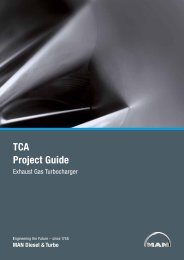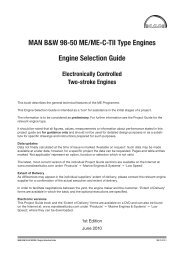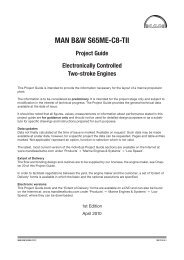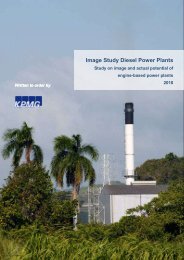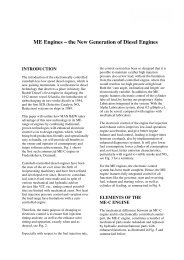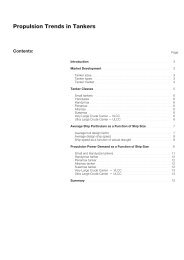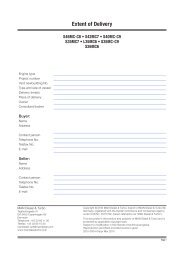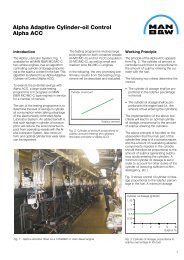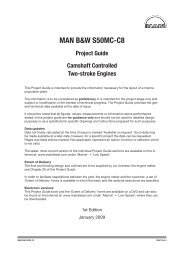This section is available on request - MAN Diesel & Turbo
This section is available on request - MAN Diesel & Turbo
This section is available on request - MAN Diesel & Turbo
You also want an ePaper? Increase the reach of your titles
YUMPU automatically turns print PDFs into web optimized ePapers that Google loves.
<strong>MAN</strong> B&W 5.13<br />
Engine Top Bracing<br />
The so-called guide force moments are caused<br />
by the transverse reacti<strong>on</strong> forces acting <strong>on</strong> the<br />
crossheads due to the c<strong>on</strong>necting rod and crankshaft<br />
mechan<str<strong>on</strong>g>is</str<strong>on</strong>g>m. When the p<str<strong>on</strong>g>is</str<strong>on</strong>g>t<strong>on</strong> of a cylinder<br />
<str<strong>on</strong>g>is</str<strong>on</strong>g> not exactly in its top or bottom positi<strong>on</strong> the gas<br />
force from the combusti<strong>on</strong>, transferred through<br />
the c<strong>on</strong>necting rod, will have a comp<strong>on</strong>ent acting<br />
<strong>on</strong> the crosshead and the crankshaft perpendicularly<br />
to the ax<str<strong>on</strong>g>is</str<strong>on</strong>g> of the cylinder. Its resultant <str<strong>on</strong>g>is</str<strong>on</strong>g><br />
acting <strong>on</strong> the guide shoe and together they form a<br />
guide force moment.<br />
The moments may excite engine vibrati<strong>on</strong>s moving<br />
the engine top athwart ships and causing a<br />
rocking (excited by H-moment) or tw<str<strong>on</strong>g>is</str<strong>on</strong>g>ting (excited<br />
by X-moment) movement of the engine. For engines<br />
with less than seven cylinders, th<str<strong>on</strong>g>is</str<strong>on</strong>g> guide<br />
force moment tends to rock the engine in the<br />
transverse directi<strong>on</strong>, and for engines with seven<br />
cylinders or more, it tends to tw<str<strong>on</strong>g>is</str<strong>on</strong>g>t the engine.<br />
The guide force moments are harmless to the<br />
engine except when res<strong>on</strong>ance vibrati<strong>on</strong>s occur<br />
in the engine/double bottom system. They may,<br />
however, cause annoying vibrati<strong>on</strong>s in the superstructure<br />
and/or engine room, if proper countermeasures<br />
are not taken.<br />
As a detailed calculati<strong>on</strong> of th<str<strong>on</strong>g>is</str<strong>on</strong>g> system <str<strong>on</strong>g>is</str<strong>on</strong>g> normally<br />
not <str<strong>on</strong>g>available</str<strong>on</strong>g>, <strong>MAN</strong> <strong>Diesel</strong> recommends that top<br />
bracing <str<strong>on</strong>g>is</str<strong>on</strong>g> installed between the engine’s upper<br />
platform brackets and the casing side.<br />
However, the top bracing <str<strong>on</strong>g>is</str<strong>on</strong>g> not needed in all<br />
cases. In some cases the vibrati<strong>on</strong> level <str<strong>on</strong>g>is</str<strong>on</strong>g> lower if<br />
the top bracing <str<strong>on</strong>g>is</str<strong>on</strong>g> not installed. <str<strong>on</strong>g>Th<str<strong>on</strong>g>is</str<strong>on</strong>g></str<strong>on</strong>g> has normally<br />
to be checked by measurements, i.e. with and<br />
without top bracing.<br />
If a vibrati<strong>on</strong> measurement in the first vessel of a<br />
series shows that the vibrati<strong>on</strong> level <str<strong>on</strong>g>is</str<strong>on</strong>g> acceptable<br />
without the top bracing, we have no objecti<strong>on</strong> to<br />
the top bracing being removed and the rest of<br />
the series produced without top bracing. It <str<strong>on</strong>g>is</str<strong>on</strong>g> our<br />
experience that especially the 7-cylinder engine<br />
will often have a lower vibrati<strong>on</strong> level without top<br />
bracing.<br />
<strong>MAN</strong> <strong>Diesel</strong><br />
Page of 2<br />
Without top bracing, the natural frequency of<br />
the vibrating system compr<str<strong>on</strong>g>is</str<strong>on</strong>g>ing engine, ship’s<br />
bottom, and ship’s side <str<strong>on</strong>g>is</str<strong>on</strong>g> often so low that res<strong>on</strong>ance<br />
with the excitati<strong>on</strong> source (the guide force<br />
moment) can occur close to the normal speed<br />
range, resulting in the r<str<strong>on</strong>g>is</str<strong>on</strong>g>k of vibrati<strong>on</strong>.<br />
With top bracing, such a res<strong>on</strong>ance will occur<br />
above the normal speed range, as the natural frequencies<br />
of the double bottom/main engine system<br />
will increase. The impact of vibrati<strong>on</strong> <str<strong>on</strong>g>is</str<strong>on</strong>g> thus<br />
lowered.<br />
The top bracing <str<strong>on</strong>g>is</str<strong>on</strong>g> normally installed <strong>on</strong> the exhaust<br />
side of the engine, but can alternatively be<br />
installed <strong>on</strong> the manoeuvring side. A combinati<strong>on</strong><br />
of exhaust side and manoeuvring side installati<strong>on</strong><br />
<str<strong>on</strong>g>is</str<strong>on</strong>g> also possible.<br />
The top bracing system <str<strong>on</strong>g>is</str<strong>on</strong>g> installed either as a<br />
mechanical top bracing or a hydraulic top bracing.<br />
Both systems are described below.<br />
Mechanical top bracing<br />
The mechanical top bracing compr<str<strong>on</strong>g>is</str<strong>on</strong>g>es stiff c<strong>on</strong>necti<strong>on</strong>s<br />
between the engine and the hull.<br />
The top bracing stiffener c<strong>on</strong>s<str<strong>on</strong>g>is</str<strong>on</strong>g>ts of a double<br />
bar tightened with fricti<strong>on</strong> shims at each end of<br />
the mounting positi<strong>on</strong>s. The fricti<strong>on</strong> shims allow<br />
the top bracing stiffener to move in case of<br />
d<str<strong>on</strong>g>is</str<strong>on</strong>g>placements caused by thermal expansi<strong>on</strong> of<br />
the engine or different loading c<strong>on</strong>diti<strong>on</strong>s of the<br />
vessel. Furthermore, the tightening <str<strong>on</strong>g>is</str<strong>on</strong>g> made with a<br />
well-defined force <strong>on</strong> the fricti<strong>on</strong> shims, using d<str<strong>on</strong>g>is</str<strong>on</strong>g>c<br />
springs, to prevent overloading of the system in<br />
case of an excessive vibrati<strong>on</strong> level.<br />
<strong>MAN</strong> B&W MC/MC�C, ME/ME-B/ME�C/ME�GI engines 198 46 72�5.7



